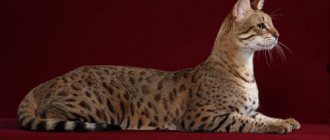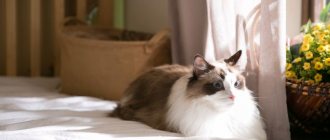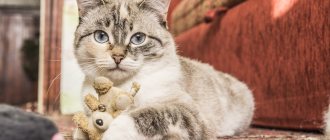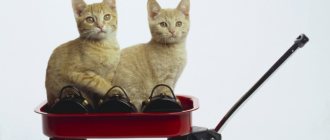What do Bengal cats look like?
Domestic Bengals are a hybrid of wild cats, whose homeland is Asia, and ordinary domestic purrs of different breeds. Their history began in the United States in the 20th century, and now they are popular all over the world.
Bengal cats combine features of wild and domestic cats. Photo: belchonock/Depositphotos
These animals are in many ways reminiscent of their free relatives and look like miniature copies of leopards and other predators. The body of domestic Bengal cats is elongated, muscular and strong, the paws are powerful, and the head is large with expressive eyes and ears that are not very large and rounded at the tips.
The color of these cats varies. The main background is most often golden or silver with a spotted, rosette or dark marble pattern. At the same time, the animals' fur is short, dense, soft, silky and pleasant to the touch.
What kind of Bengal breed is this?
Although there are no special difficulties in caring for and maintaining a Bengal cat, it must be taken into account that it will not simply be a beautiful, prestigious piece of furniture. The unusual habits, physiological qualities, and distinctive character traits of cats of the Bengal breed are determined by its origin. When planning to purchase a Bengal, a person must weigh, in addition to the argument of attractive appearance, the following features of the animal:
- by nature has a strong, often large body, sinewy paws with powerful jaws, strong claws of a forest predator;
- has well-developed hunter instincts, so it will not get along in the same space with rodents and birds;
- can be unsociable - hide, get scared, but, like her Asian ancestors, she is capable of aggression only in very rare exceptional cases;
- refers to very talkative pets - when expressing emotions, during communication, especially while eating, Bengals use a wide range and range of sounds, sometimes turning into a menacing growl, even screams;
- has an extremely active temperament, prefers high places to spend time.
In felinology, it is believed that Bengal cats are more suitable for experienced owners, since their disposition and behavioral characteristics cannot be called simple.
Only if the owner is ready to raise a Bengal from a very early age will the pet become understanding, flexible, sociable, and even affectionate. That is why it is advisable to have experience and at least minimal knowledge in animal psychology.
What is the character of Bengal cats?
Bengals are quite active, curious and playful animals. Moreover, this character manifests itself not only at a young age, but throughout their lives. Therefore, you need to raise a kitten from childhood, so that over time it does not turn into an uncontrollable pet.
Bengal cats are very active and playful. Photo: belchonock/Depositphotos
Animals of this breed are very smart. So, after special training, Bengals can follow simple commands, such as sit, give a paw, and even fetch objects. They are capable of “learning” themselves, so they open cabinet doors and bedside tables without much difficulty.
How do Bengal cats get along with adults?
Such pets are sociable, become attached to people and willingly make contact. They love to be in human society, follow their owner around the apartment with interest and do not ignore everything that happens.
When alone, these cats get bored and are completely sincerely happy when their family members return home. And if you simply ignore your pets for a long time, they will probably remind you of themselves by meowing and will persistently demand attention to their person.
How do Bengal cats get along with children?
Playful and affectionate cats get along well with younger family members and often act as companions in their games. They are not inclined to show aggression and are more likely to retreat if they are not in the mood for communication. Although it is better not to leave them with children who do not yet understand that this is not a living toy in front of them. After all, Bengals can, for example, scratch their young owners, trying to escape from too tight hugs.
How do Bengal cats get along with other animals?
Bengals get along well with dogs.
Photo: pascalegueret / Depositphotos Bengals are natural predators. Therefore, they will not be able to make friends with parrots and hamsters, but will simply perceive them as potential victims. As for dogs and other cats, representatives of this breed get along well with them and practically do not conflict.
Socialization of kittens
Knowing how to raise a Bengal kitten, you will never encounter his aggression. It is when hunting that the tailed “child” can be sharp (he is excellent at catching mice). But the pet will get accustomed to the family pretty quickly. Interestingly, raising such a cat is not particularly difficult. These creatures are very smart and observant, so they learn many useful skills from people with interest.
Socialization of the kitten takes place without unnecessary problems. True, the animal, as a rule, treats family members, including children, differently (more precisely, the cat chooses one owner). A pet can watch its pet for hours, it does not like to let it out of its sight.
What living conditions do Bengal cats require?
Bengals are energetic and active cats that need exercise. To ensure the required level of activity, it is best to install for such an animal a full-fledged play complex with shelves and posts. This way the Bengal cat will be able to splash out its energy and not get bored. Although, even with its own play center, a restless pet will probably explore all the cabinets, bedside tables and shelves in your apartment.
The cat will also definitely appreciate balls, mice and other toys with which you can have fun and frolic. The animal will also need a scratching post that will protect the furniture from its sharp claws.
To diversify your pet’s leisure time, you can take him for walks. It is best to take out a Bengal on a harness so that it does not accidentally run away. You should not let it go unattended: the cat may get lost, be harmed by street animals, or become infected through contact with them.
Take care of your pet's safety. Photo: ingus.kruklitis.gmail.com / Depositphotos
Bengal cats, like other cats, are curious and have a passion for hunting. Therefore, it is advisable to install special grilles on double-glazed windows. This will help protect your pet from falling out of the window while jumping after a flying bird or a falling leaf.
Grooming
1.1 Bathing
Many owners periodically wonder how to properly wash a cat, how often and whether it is necessary to do it at all.
Bengals have short hair, but if you feed them well, it will be smooth, thick, and shiny. There will be no problems caring for this coat. Basically, the animal will cope on its own. It is not necessary to wash if there is no visible dirt. If there is still a need for bathing, this should be done using special shampoos for animals. “Human” shampoo may not be suitable and may cause allergies. Better not experiment.
1.2 Combing
If a Bengal cat, as mentioned above, is fed with high-quality food and periodically given vitamins, then such a pet will look healthy. His coat will always be smooth, shiny and thick. Therefore, there is no special care for his fur coat. The only thing is that you can periodically comb the animal with a special brush to rid it of dead hairs.
For combing, I recommend using a special glove (as in the picture), or any rubber or silicone brush. Furminators are not suitable because... are used to comb out the undercoat that Bengals do not have.
1.3 Manicure
I have often seen cats bite and gnaw their claws while washing themselves. In this way they try to shorten them. But neither this nor grinding them down on a scratching post is sometimes enough. The animals themselves cannot fully carry out this procedure and here they will need your help. Sometimes owners don’t understand why trim their claws if the cat, for example, hardly damages the furniture and doesn’t scratch itself. It is important to remember that you only need to trim your claws if they are too long and your cat is clinging to everything with them. In such a situation, their excessive length interferes with the animal itself and the owner’s task is to help.
How to cut your nails correctly
Now that you have decided to trim your cat’s claws, you should read in detail about how to do it correctly and whether you need to buy special tools for this. In fact, there is nothing complicated about it. All you need is: someone to help you, hair clippers, a hemostatic agent and cotton pads (just in case). Proper trimming of cats' claws is the key to the success of the entire procedure. The main point that you should pay special attention to is how to trim a cat’s claws so as not to cause her pain and so that the procedure does not become too debilitating for her.
To learn how to trim claws correctly, you need to remember: before starting work, determine exactly where the blood vessel (pulp) ends in the cat's claw. Many cats have transparent claws, so by holding it up to the light, you can easily identify the pink vessels and understand how long the claw can be shortened. This must be done very carefully so as not to touch the vessels. Otherwise, it can lead to bleeding and possibly further inflammation. If your pet’s claws are black, then determining the position of the vessel is not so easy. In this case, shorten them quite a bit. It is better to repeat the haircut in a couple of weeks.
While the kitten is small, we trim his claws in his sleep so as not to irritate him.
There are scissors and guillotine nail clippers. I tried both. Scissors turned out to be more convenient.
1.4 Ear sanitation
Sanitation of the ear canal and ears of animals should be carried out regularly. Its purpose is to cleanse the ears of accumulated earwax, as well as other secretions. Regular and proper sanitation is important for the prevention of otitis media. Normally, the ears should not bother your pet at all - they should not hurt, itch, etc. There should also be no unpleasant odor, and the ear should not be inflamed or reddened. Sanitation of the ears is carried out as they become dirty so that the inside of the ear is always clean. Sanitation is performed as follows.
A small amount of saline solution or a special preparation that dilutes earwax is instilled into the ears. For sanitation, you cannot use hydrogen peroxide, alcohol solutions and other irritating drugs - this can provoke the development of otitis media. Immediately after the drug is instilled, you need to gently massage the ears for a few seconds. At the same time, you should not let your pet shake its head.
After the massage, you can allow the animal to shake its ears so that the fluid comes out of the ear canal.
Next, you need to remove the liquid in the ears using a napkin.
Under no circumstances should you clean your ears with cotton swabs, swabs, or hard objects. This can lead to injury to the ear canal and also provoke the development of otitis media.
The condition of the ears must be constantly monitored - they must be periodically inspected for contamination. If you can see that your pet’s ears are bothering you (he constantly scratches them, often shakes his ears, and won’t let you touch them), you should consult a veterinarian.
1.5 Eye care
It is necessary to remove any discharge or crusts from your pet's eyes with a damp cotton swab. Always wipe from the outer corner of the eye to the inner corner, using a new swab for each eye. Use specialized cleaning products (lotions or eye drops, such as Diamond Eyes). Many people use an excellent folk remedy - dipping a cotton swab into decoctions of medicinal herbs (for example, chamomile), but you can also wipe your eyes with boiled water. If you notice unusual discharge during eye care, consult your veterinarian.
How to feed Bengal cats
It's up to you to decide which diet to choose for your pet. The easiest option is to give your cat ready-made food, which can be wet (canned) or dry. Moreover, it is better to opt for complete products from well-established brands. Such food contains all the necessary microelements, vitamins, carbohydrates, proteins and fats.
You need to choose ready-made food taking into account age: there are separate menus for kittens and adults. There is also special food for sterilized, pregnant and lactating cats, and for those suffering from allergies and other diseases.
Give your pet only high-quality food. Photo: kosmos111 / Depositphotos
In addition, you can feed your pet natural products, including meat, offal, vegetables and more. Such a diet must be thoughtful so that the cat receives everything it needs for health along with its food.
As for regular food from our table, this is not the best option. In addition, some products that are familiar to us are simply dangerous to the health of pets. For example, cats should not be offered fried, salty, spicy or even sweet foods.
Regardless of the diet chosen, the animal must always have access to clean drinking water.
History of the breed
The Bengal cat is a hybrid of a domestic cat with a wild Bengal cat (Prionailurus bengalensis) as a result of the work of phenolenologists. In the 1960s, American scientist Jane Mill brought a wild Bengal cat from Taiwan to Arizona. Either she wanted to save a wild animal in this way (the species was threatened with complete extermination), or she simply decided to buy it as a souvenir.
In the house of an American woman, a small leopard accidentally “became friends” with a domestic cat, resulting in the birth of offspring. This is how the idea of creating a breed with the appearance of a leopard and the character of a domestic cat arose.
In 1963, Jane brought a representative of the wild species from Asia for breeding work and bred it with the American Shorthair. But in 2 litters, the males were born sterile, but wild females with domestic cats gave birth to offspring capable of reproduction.
The work was long. But she was crowned with success. For a very long time, Bengals were not recognized by any phenological association because of their wild ancestors. But in the 80s they finally got to the exhibition, where they created a sensation. And in 1991, the breed was recognized and given official status.
How to care for Bengal cats
The silky and short coat of Bengals needs to be brushed once a week or two using a special brush. If you accustom your pet to this procedure from childhood, it will not cause any special problems.
Caring for the beautiful coat of a Bengal will not cause problems. Photo: Evgenia Stadnikova / Shutterstock
Bengal cats are very clean, so they do not need frequent bathing. Water treatments may be necessary if the pet is very dirty. At the same time, washing Bengals will not cause any special problems. Cats of this breed are calm and even interested in water, play with the streams with pleasure, and some are not even averse to having fun in the bath.
You also need to pay attention to the animal’s claws, even if the cat regularly uses a scratching post. You can trim them at home, but if difficulties arise with the procedure, it is better to contact a veterinary clinic. As for ear hygiene, it is advisable to inspect them at least a couple of times a week and clean them as they become dirty using special lotions or other products.
Behavior: what are the features?
Habits are similar to those of a dog. Cats are smart, quick-witted, and easy to train. They do not like to be forcibly picked up and squeezed. They will allow this only when they themselves want to. In the family they prefer to choose a leader, a beloved owner, to whom they become most attached. Bengals are flexible, sociable, and playful. They make good rodent hunters. Show leadership qualities. If there is another animal of the same sex at home, a fight may occur. They love children and enjoy playing with them for a long time.
What diseases do Bengal cats suffer from?
Representatives of this breed are strong and hardy animals. But they are also prone to certain diseases. Among them:
- Retinal atrophy (PRA-b) is an inherited disease that eventually leads to complete blindness.
- Hypertrophic cardiomyopathy (HCM) is a heart disease in which the walls of the ventricle thicken, leading to problems with the functioning of the circulatory system.
- Erythrocyte pyruvate kinase deficiency (PK deficiency) is a condition that leads to hemolytic anemia associated with impaired functioning of red blood cells.
- Flat chest syndrome (FCK) is a disease that appears in kittens in the first months of life and can be fatal.
- Dry nose syndrome. It appears in young animals under one year of age, first in the form of crusts and cracks; if neglected, ulcers may appear.
Also, Bengals, like any other cats, can suffer from food and contact allergies, problems with the digestive and genitourinary system, skin diseases and more.
Even a healthy animal needs to be constantly and carefully monitored. If there are any changes in his behavior or suspicious symptoms, it is better to immediately contact a veterinary clinic. This will help you take action in time and avoid bad consequences.
Catering rules
Until the age of one month, babies, as a rule, are fed only breast milk. After 4–5 weeks, new foods begin to be introduced into the diet. This could be a scraped chicken breast, scalded with boiling water. A little later it will be veal, beef or turkey cut into small pieces. Add porridge with eggs to your diet. Be sure to include raw and boiled vegetables: carrots, pumpkin, beets, broccoli, cauliflower.
Keep in mind that at the age of 8–9 months, a cat’s weak point is the stomach (diarrhea often occurs). Experts recommend feeding animals very carefully and choosing premium food:
- Husse;
- Grandorf;
- Acana;
- Royal Canin;
- Orijen;
- Fitmin (grain-free).
The packaging must indicate that the food is intended for feeding kittens. Pay attention to the age recommendations on the packaging. Some kittens have individual intolerances and skin allergies - in this case, purchase hypoallergenic formulations.
Consider the physical activity of Bengals. For neutered cats with a tendency to obesity, low-calorie recipes are suitable. Try not to give such economical options as Felix and Whiskas.
There should always be fresh water in the bowl, which should be changed 1-2 times a day.
What proponents of natural nutrition should know:
- 80% of the diet should be meat, the best option is beef without fat.
- 10–15% – edible bones: neck, joints, cartilage (except tubular).
- 5–10% – tripe: chicken heart, stomach, lung.
- You can also give chicken, rabbit, and veal as meat.
- The meat is first frozen and served raw.
- You can sometimes feed them boiled pieces.
- Liver is given rarely and little by little.
- Pork and lamb are prohibited for Bengals.
- You cannot offer hot or cold food.
- Cats are given boiled, boneless sea fish; cats do not need fish.
- Healthy dairy products include kefir, fermented baked milk, and cream.
To breed “little leopards” and have healthy offspring, take care of vitamins and minerals. A veterinarian will help you make the right choice.
What to look for when buying a Bengal cat
Before buying a kitten, first decide on your plans for it. If you dream of a show career for your future pet, choose fluffies from the “show” class. Their price is high, but such kittens are potential champions. To breed and obtain high-quality offspring, it is better to focus on the “breed” class. And if you are just looking for a pet for your soul, buy kittens of the “pet” class, the price of which is usually affordable.
Before purchasing, decide on your plans for your pet. Photo: LElik83 / Shutterstock
In addition to prospects, be sure to pay attention to the health of the animal and its appearance. The future pet should be active, mobile and moderately well-fed. He is also required to receive all age-required vaccinations.
When you conclude a deal, make sure that you receive a package of documents along with the kitten: a purchase and sale agreement, a veterinary passport and a metric (cat “birth certificate”), on the basis of which a pedigree is issued.
If you were not given any documents upon purchase, take care of obtaining a veterinary passport and make sure that the kitten is vaccinated. But it will not be possible to draw up a pedigree for such an animal, since it is not known who its parents are.
Choosing and caring for a kitten
If you just choose a pet, the choice is made on the baby you like best. The main thing is that he is healthy. This is evidenced by clean eyes, good appetite, shiny coat, and absence of swelling near the anus. When choosing a show-class pet, there are more requirements. The baby must meet the standard. This applies to color, exterior and character.
Three types of color are considered classic:
- rosetted (roset) – spots have a light base with a dark edging;
- marbled – dark patterns on a light background;
- spotted color (spotted) with evenly colored spots on the pet’s fur.
There are also more rare colors: lynx, mink, sepia. Until recently, Bengals were dominated by warm coat tones. Today the blue color is recognized, and snow Bengal cats have appeared. Moreover, the color of kittens does not appear immediately. Only in sexually mature animals does it become as bright as possible. The new owner can only guess what color a 4-month-old baby will have. Therefore, it is important to buy kittens only from reputable breeders.
Starter kit for rehoming a Bengal kitten
It will be different in each nursery. As a rule, it includes:
- contract of sale;
- veterinary passport with vaccination records;
- pedigree or metric indicating registration in the club;
- food that the baby is accustomed to;
- toilet filler;
- recommendations for feeding a kitten.
Bengals and their environment
This breed of cat is very active and curious. They will always find a corner to crawl into, something to sniff, and a place to hide. They are interested in everything, especially if a new thing has appeared in the house.
A Bengal woman will definitely find something to play with in the house. Therefore, it is best for her to purchase her personal toys in advance.
Such pets are very friendly and sociable, and therefore can easily get along with other animals in the house. They will happily play with them at their leisure. If the Bengal does not have a friend, then the owners need to replace him.
Since this cat breed needs to expend its energy, you need to play with your furry friend. Be sure to come up with games. Play hide and seek with him, chase, throw a jingling ball, tease him with a string, and so on.
In general, make sure that your animal does not get bored and expends a sufficient amount of its energy. Moreover, such games always bring Bengal women and household members closer together. In addition, during your absence, the house will always remain in order, because the pet will know that you will come, and it will have someone to play with. This will increase his affection and love for you!
The Bengal cat breed is quite smart. Therefore, you can direct all your games in the right direction, for example, by training an animal. Some commands are very easily learned by the furry animal. You can teach a kitten to the word “no” so that he understands where he can climb and where he can’t.
Some breeders use a water pistol during training, but this method may not always be successful. Because water can get into the eyes, ears, or scare the kitten so that it will hide in a corner and sit there.
Therefore, experts suggest lightly pinching the kitten's neck - this method works well, since this is what their mother did. Therefore, you just have to continue her method of education.
How long does it last?
The cat's readiness to mate usually occurs on the third day of estrus and lasts a week.
The duration of the process is individual for each Bengal female. In most cases, it lasts 5-8 days. The break between heats can last from 2 weeks to 3 months. The physiological process is divided into 4 stages:
- Proestrus. Lasts 2 days. It is distinguished by a change in the behavior of the Bengal cat, an increase or loss of appetite, swelling and moisturizing of the genitals. During this period, the cat is not yet ready to mate; she will reject all the advances of the male.
- Estrus. Directly the heat itself. Duration from 4 to 8 days. During this period, the Bengal cat meows loudly, calling for a partner. At this stage, the female is ready for mating, ovulation occurs within 24 hours.
- Metaestrus. The stage lasts approximately 10 days after mating and ovulation. During this period of time, the Bengal cat aggressively drives the male away from itself.
- Anestrus. The stage of disappearance of all signs of estrus if fertilization has not taken place.
A Bengal cat's readiness to conceive can be determined by stroking its back. A positive result will be raising the pelvis and tail up and stamping the hind legs in place.
Expert advice
What do experienced experts of this breed advise:
- Bengal cats love heights, so the owner should imitate wild conditions for the pet as much as possible - install tunnels, buy a cat tree or other toys. Then the student will feel more comfortable.
- The cat instantly remembers new information, you can even teach it to turn the door handle to open them, or show it how the switch works. But at the same time, you need to think about whether the new skills will be useful.
- An adult animal should be walked outside and preferably on a leash. Do not forget that your pet is a descendant of a wild animal.











